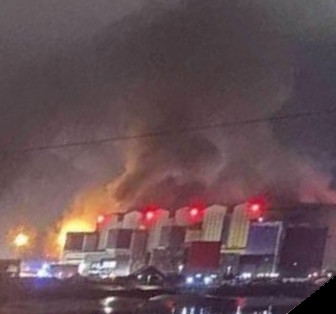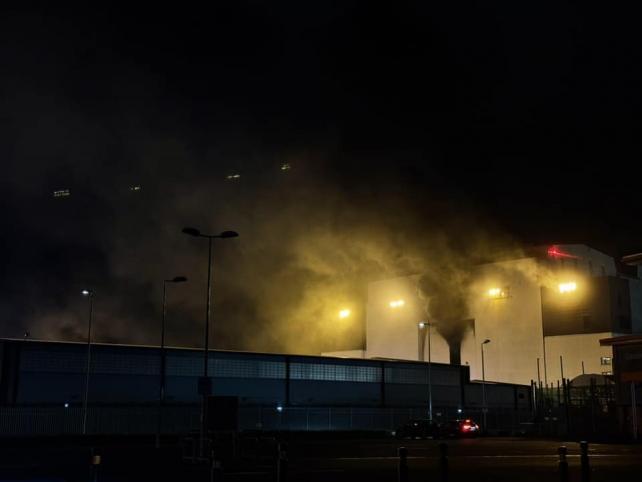A fire, which erupted in the Devonshire Dock Hall at Barrow-in-Furness during the early hours of 30th October, burned for at least 14 hours and saw seven workers taken to hospital. Large clouds of smoke rose overnight from the Hall, where the UK’s submarines are assembled, and local residents were advised to keep windows closed. The fire was first reported at the BAE Systems site at 00:44 am and it was only announced that firefighters had moved to damping down the fire the following afternoon, at 2:50pm.
Initial reports said that two workers were taken to hospital, suffering from smoke inhalation, and that they had been discharged from hospital by the early afternoon. A government statement later in the day said that seven workers had gone to hospital as a “precautionary measure” and were subsequently released. A statement from Cumbria Police said that there was no nuclear risk from the blaze. Submarine reactors are not fuelled until they are ready to leave Barrow, so it is unlikely that any nuclear material was in the Hall at the time. The advice for residents to keep windows closed was due to the risk of inhaling particles, such as metal and other pollutants.
The fire
The fire began when workers were on their night shift, with between 200 and 300 individuals at work. Sections of submarine hull are constructed at other parts of the site, then assembled in the Devonshire Dock Hall. At the time, at least two submarines were known to be present in the Hall: HMS Agincourt, the seventh and final Astute-class submarine, and HMS Dreadnought, the first of the new Dreadnought-class submarines. Astute submarines are nuclear powered, but not nuclear armed. Dreadnought submarines will be both nuclear powered and nuclear armed

The Hall is large enough for three submarines to be assembled concurrently, but the sixth Astute-class submarine, HMS Agamemnon, has been completed and left the hall earlier in October. It is not known if assembly of the second Dreadnought-class submarine, HMS Valiant, had begun at the time of the fire. The extent of damage to the submarines from the fire has not been made public.
Briefing to the press has suggested the fire began in the area where HMS Agincourt was being assembled and that the cause may have been equipment failure. One rumour circulating locally is that a ‘shot blaster’ exploded and caused a fire which spread to other parts of the submarine. Firefighters were unable to safely access the blaze, and had to wait until it burned out. A shot blaster is a piece of equipment used to clean or finish metal surfaces by blasting with abrasive particles.
Long-term consequences
The external structure of the Hall does not appear to have caught alight, although some parts of the exterior show visible signs of smoke damage. Work continued as normal on other parts of the BAE Systems site, but non-essential staff were being kept away from the Hall. The long-term effect on work at the site remains to be seen.
While the Hall may be structurally undamaged and work is able to recommence without repairs being needed to the building itself, the investigation into the fire and recreating a safe working environment will undoubtedly take time. Remediating any damage done to HMS Agincourt will entail delays to both the Astute and Dreadnought programmes, as its presence in the Hall means assembly of the third Dreadnought submarine cannot begin. Any damage done to HMS Dreadnought will almost certainly cause delays to that submarine’s planned in-service date. Both programmes were already facing substantial risks to their planned timetables, and the reliability problems in the in-service Vanguard submarine fleet will only be exacerbated by further delays to the Dreadnought schedule.
